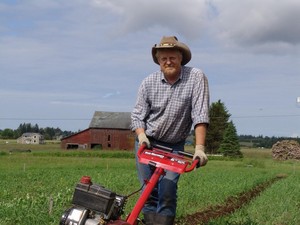16 Oct Fri 2009
Niche Marketing From Another Perspective
Most direct marketers are aware of the importance of niche creation. As farmers or artisans, we don't need to sell to everybody, like the supermarkets. We can survive by selling to a select few. Where the disagreement and confusion comes in seems to be how wide the niche needs to be. In my situation, I only need 60 loyal customers/shareholders to make a living. Other sustainable farmers think they need a large, undefinable number of customers and this naturally leads to tactics like third party organic certification, expanding markets to the Seattle area (100 miles away), and three days a week at farmers markets. But the flaw in these marketing ideas is not quantifying how many customers you actually need. You don't have to sell to everybody and you can survive by actually narrowing the niche to your most loyal customers/shareholders/associates/comrades/what-have-you. I would rather have fewer customers who actually understand simple food grown sustainably from soil that is well-cared-for.
For another aspect of niche creation, let's look at the New York Times Book Review of Peter Richardson's new book on Ramparts Magazine, A Bomb in Every Issue, just published by the New York Press. Here is the penultimate paragraph in the review.
Although Ramparts continued to break important stories that the establishment press ignored, the magazine didn't glisten after Hinckle the impresario left. Richardson attibutes the decline to a number of causes. Like all niche-creating magazines, Ramparts attracted competition that wound up stealing readers; at the same time, it abandoned part of its audience by embracing New Left orthododoxy, which "rejected anything short of revolution." The magazine also ran out of liberal millionaire donors. Its accrued losses must have run into the tens of millions, making it unlike pantheon magazines that made money.
Notice the sentence, "Like all niche-creating magazines, Ramparts attracted competition that wound up stealing readers . . ." We can see this same worry in the rise of niche protection in organic/sustainable agriculture. As an example, when we moved the Ferndale Farmers Market onto the Riverwalk in downtown Ferndale in 2008, one of the members of the board of the Bellingham Farmers Market asked us to open Sundays instead of Saturdays, so we wouldn't compete with them. Personally, I thought this was ludicrous, since we were so much smaller and not a real threat to them. Another example is that of another organic farmer in Whatcom County, who started using "Startlingly Fresh" in his marketing literature a year after I started my tag line of "Fresh, Absolutely!"
Now, both of these examples are tempests in teapots. It didn't really hurt the Bellingham Farmers Market to have competition, simply because direct-marketed, organic/sustainable produce is less than 1% of what people buy in Whatcom County. By the same token, copying my tag line concept doesn't hurt me either, since our produce is such a miniscule percentage of what people buy. Our task is really to create more niches. One could say that we are broadening the "organic/sustainable" niche, but we really do have a multiplicity of niches. I cater to the more politically active, while the unnamed farmer above caters to the warm & fuzzy co-op crowd. In other words, let's broaden our number of niches, rather than broadening a large generalized niche that we call "organic" and "sustainable." An added bonus to this specificity will be that the big brouhaha over certified organic will just naturally fall away. Put another way, by narrowing our niche to a few valued customers, they will of course be local and the local, community-building aspects of direct marketing will naturally fall into place, WITHOUT giving Washington state and the USDA their pound of flesh.
Finally, Ramparts did indeed have a hand in its own demise, which the author attributes to the magazine embracing "New Left orthodoxy." The emphasis on "New Left orthodoxy" is ridiculous of course, as the real trend of the 60's reached its conclusion in a synthesis of the hip & radical and culminated in co-ops, back-to-the-landers, the environmental movement and an enhanced feminist movement. Since I was there, I can state with some experience that the "New Left orthodoxy" was honored in the breach more than in fact. Bespectacled potty-mouthed Marxists in their ratty outfits were still around, but once they had to actually burn a few calories to stock shelves or hoe carrots, they soon left for university positions teaching political science. The real reason for Ramparts' demise was the departure of Warren Hinckle, although their business model of extracting guilt money from liberal donors was only viable when the economy was flush. After Nixon wrecked the economy, the funding from liberal patrons dried up. Ramparts did indeed serve a useful role in the journalism of the 60's (the real journalism, as typified by the underground newspapers I used to sell), but it was an artifact of the era. It may have some lessons for us still, but we really need to think creatively ourselves and solve our problems today, right now, pronto. One way to go about this is to think about niche marketing in a more creative, sophisticated manner.

